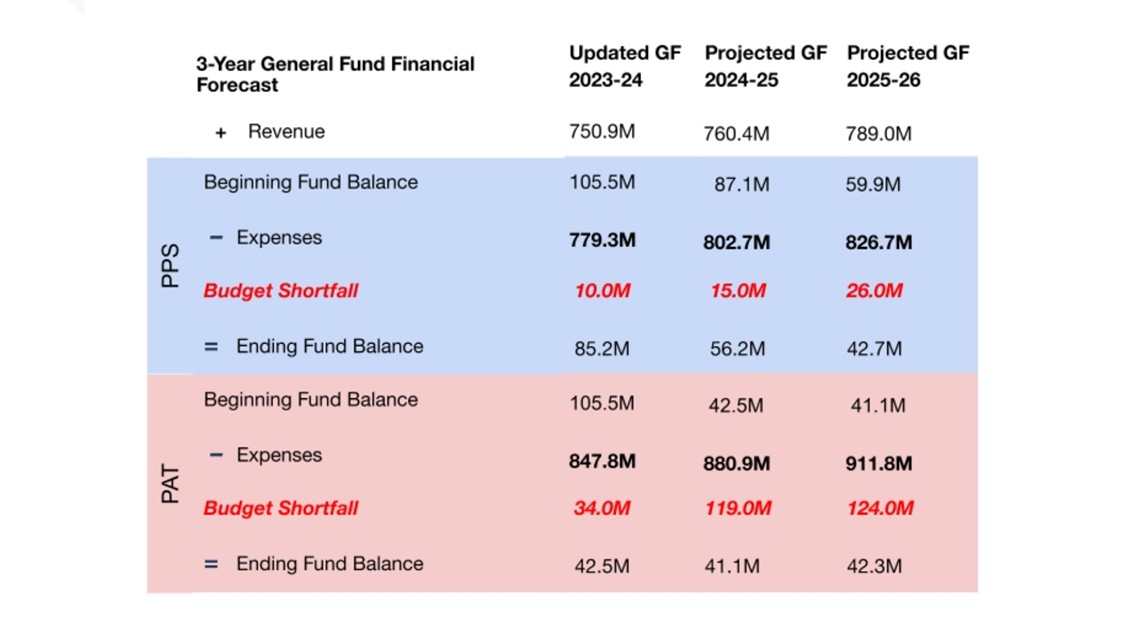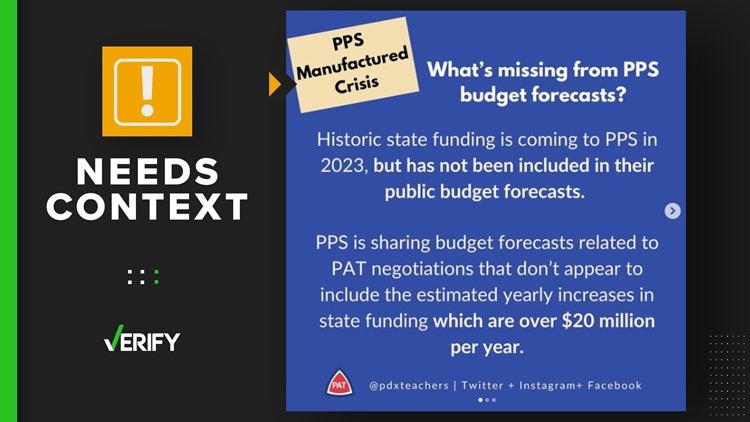PORTLAND, Ore. — About 4,000 educators with Portland Public Schools went on strike last week after the district and the Portland Association of Teachers failed to reach a new contract agreement. Bargaining has deadlocked on sticking points like salaries, class sizes, planning time and student discipline procedures.
The district and the union have both published steady streams of information leading up to and during the strike, much of it focused on the gap between the costs of the contracts proposed by each side. Unsurprisingly, there's some disagreement about the size of the gap and the financing available to bridge it. But one recent Instagram post from the union was particularly eye-catching:
The post asserts that the district's budget forecast leaves out a key piece of revenue: an annual infusion of more than $20 million from a larger-than-expected State School Fund package passed by the Oregon legislature. The post claims that the additional revenue could mostly cover the cost of the union's wage proposal.
THE QUESTION
Did Portland Public Schools publish budget projections that omitted additional revenue from a larger-than-expected state school funding package?
THE SOURCES
THE ANSWER

The district's revenue projections are based on a budget that was adopted before the legislature passed the funding bill, so they don't include the added funding. But those extra added dollars have been acknowledged in other materials published by the district.
There's also disagreement about the size of the gap between the two sides' contract proposals, and therefore disagreement about how much of an impact the added state funding could make.
WHAT WE FOUND
The Instagram post appears to be a shortened version of a memo on the union's website, which states that the PPS budget for the current school year assumes a $9.9 billion allocation to the Oregon State School Fund. But state lawmakers ultimately approved $10.2 billion, the memo says, so PPS will receive over $20 million more per year than predicted.
District and legislative documents bear that out. The PPS draft budget released in April states that the district "based the budget on state funding of $9.9 billion State School Fund," and House Bill 5015 allocated $10.2 billion to the fund for the 2023-25 biennium.
During an Oct. 2 bargaining session, the PPS team delivered a presentation explaining that the district officially adopted its budget on June 13. House Bill 5015 didn't pass until later that month — it was one of hundreds of bills that got held up for weeks due to the Republican Senate walkout. The presentation confirmed that PPS now expects to receive over $20 million in additional state funding for the current school year.
Did the district omit the funding?
The union's Instagram post appears to be referencing a chart that the district has published multiple times, which shows PPS's existing general fund balance and expected revenue for the next three years, weighed against what the district says are the costs of its own contract proposal and the union's proposal.
Editor's note: The district has adjusted the chart repeatedly to account for updated contract proposals from both sides, meaning the version embedded below is somewhat outdated. The projected revenue numbers are consistent, however.


According to a district official, the top revenue line does omit the added $20 million per year, because the estimates are drawn from the district's adopted budget, which has not yet been officially amended. But the money isn't missing from the district's communications entirely — it's acknowledged in the Oct. 2 presentation.
It's also worth noting that the state revenue package is only for the 2023-25 biennium, so it only provides the extra $20 million for those two school years. Any additional funding for the 2025-26 school year will depend on what lawmakers put into the state education fund in 2025.
Would the extra money cover wage increases?
The answer to this question is less clear, because the union and the district have published different assessments of the gap between the proposals. The district has repeatedly asserted that the union's plan would cost about $243 million over three years for salary, overage, stipends and health insurance, while the PPS plan would cost about $143 million.
The union's Instagram post claimed that the total three-year cost of its proposed wage increases was about $68 million, compared to about $30 million in the district proposal. It's unclear why the numbers differ, although the phrasing of the post suggests that the union might be referring to salaries alone and not other compensation. PAT did not reply to a request for clarification.
According to the union, the extra $20 million in state revenue for three years is enough to close the gap between the proposals and nearly enough to cover the entire added cost of the union's wage proposal. According to the district's math, it would fall short of being able to do either of those things.
Editor's note: The union submitted a new contract proposal on Thursday with lower salary requests, meaning the above numbers may now be outdated. However, there is still a large gap between the two sides on salaries, and the above conclusion is still accurate.
Other financial holes
The $10.2 billion state funding package was the largest in Oregon's history, but in a memo shortly after it passed, the Oregon School Board Association warned that school districts throughout the state will still be left facing budget crunches. The bare minimum to avoid service cuts in most districts would actually have been $10.3 billion, the association argued, and an ideal package would have gone even higher than that.
PPS officials offered a similar assessment of the state funding package, and pointed to some other parts of the district's revenue chart for context.
Even under the district's own proposal, PPS would wind up burning through more than half of its reserve fund balance over three years, from $105.5 million down to $42.7 million — and it would need to find an additional $51 million in cuts over those three years. So when the time comes to update the budget and officially allocate the added state finding, teacher salaries won't be the only priority competing for those dollars.



